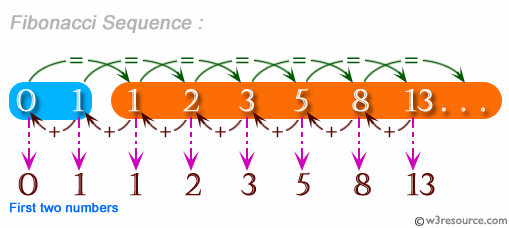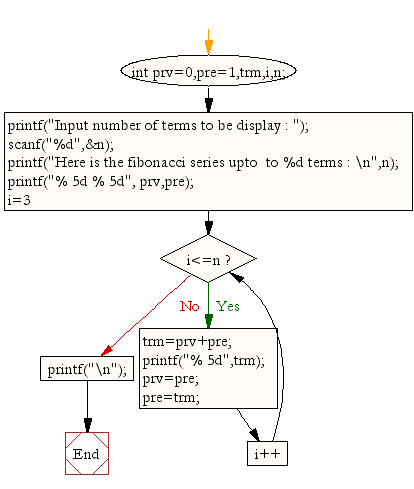C Exercises: Display the first n terms of Fibonacci series
C For Loop: Exercise-35 with Solution
Write a program in C to display the first n terms of Fibonacci series. The series is as follows:
Fibonacci series 0 1 2 3 5 8 13 .....
Pictorial Presentation:

Sample Solution:
C Code:
#include <stdio.h>
void main()
{
int prv=0,pre=1,trm,i,n;
printf("Input number of terms to display : ");
scanf("%d",&n);
printf("Here is the Fibonacci series upto to %d terms : \n",n);
printf("% 5d % 5d", prv,pre);
for(i=3;i<=n;i++)
{
trm=prv+pre;
printf("% 5d",trm);
prv=pre;
pre=trm;
}
printf("\n");
}
Sample Output:
Input number of terms to display : 10
Here is the Fibonacci series upto to 10 terms :
0 1 1 2 3 5 8 13 21 34
Flowchart:

C Programming Code Editor:
Improve this sample solution and post your code through Disqus.
Previous: Write a program in C to find the prime numbers within a range of numbers.
Next: Write a program in C to display the such a pattern for n number of rows using a number which will start with the number 1 and the first and a last number of each row will be 1.
What is the difficulty level of this exercise?
Test your Programming skills with w3resource's quiz.
C Programming: Tips of the Day
Static variable inside of a function in C
The scope of variable is where the variable name can be seen. Here, x is visible only inside function foo().
The lifetime of a variable is the period over which it exists. If x were defined without the keyword static, the lifetime would be from the entry into foo() to the return from foo(); so it would be re-initialized to 5 on every call.
The keyword static acts to extend the lifetime of a variable to the lifetime of the programme; e.g. initialization occurs once and once only and then the variable retains its value - whatever it has come to be - over all future calls to foo().
Ref : https://bit.ly/3fOq7XP
- New Content published on w3resource:
- HTML-CSS Practical: Exercises, Practice, Solution
- Java Regular Expression: Exercises, Practice, Solution
- Scala Programming Exercises, Practice, Solution
- Python Itertools exercises
- Python Numpy exercises
- Python GeoPy Package exercises
- Python Pandas exercises
- Python nltk exercises
- Python BeautifulSoup exercises
- Form Template
- Composer - PHP Package Manager
- PHPUnit - PHP Testing
- Laravel - PHP Framework
- Angular - JavaScript Framework
- Vue - JavaScript Framework
- Jest - JavaScript Testing Framework
